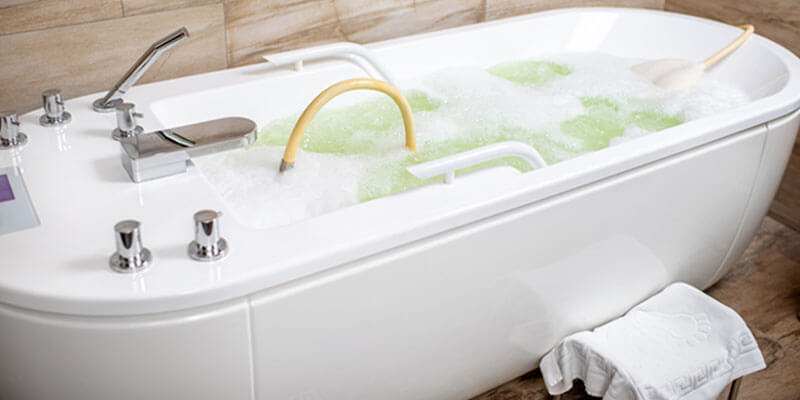Caulk cracking around a tub might sound like a common problem for those people who have tubs at their homes. Basically, they take this issue lightly. But in real caulk, cracking is a worse thing.
Bathroom tubs’ caulk can crack for a variety of reasons. However, the major reason could be using the improper type of caulk.
You should question yourself: why is the caulk around my tub cracking?
Before damaging the tab more, in this article, we will discuss the caulk cracking topic in detail. So read this article carefully.
What Are the Reasons Caulk Around My Tub Cracks?
Caulk cracking around the tub is not a pleasant incident at all. While the caulk cracks, it creates a gap between the tab and the surface. That gap can easily be filled with fungi, mold, and mildew. It happens naturally because, as we know, mold can easily become colonized in a moist place.
If the tub area’s caulk is cracking, then re-caulking the tub could be an option. But the process is quite lengthy and costly. There is no point in wasting money unnecessarily when you can save it wisely. So, instead of re-caulking, finding the cause and making the repair is the best choice for any tub user.
Suppose someone has been facing this cracking problem for a long time. Then it is high time users find a way how to stop caulk cracking. There are a few possible causes of caulk cracking. That he needs to solve, such as:
Reason 1- Using Inappropriate Caulk
Most people count every caulk in a similar manner, but this is a wrong concept. A good caulk depends on its price, quality, and processing materials. A branded quality caulk price starts at $10.
As a result, stop using this kind of caulk for your tub, which is less than 10 dollars. So a user should use new, high-quality caulk that is both flexible and watertight for his bathroom.
Reason 2- Applying New Caulk Over the Old One
Stop being so hurried after seeing the caulk cracking. Do not apply the new caulk immediately over the old caulk. Firstly, remove the old caulk thoroughly, then apply. But suppose someone does not know how to remove caulk; he should follow a few steps.
- A caulk softener should be used to soften the caulk
- Clean the caulk with a knife
- Alcohol can be used to clean the tub’s surface
- Painter’s tape should be used to mark the cracking zone
- Put the caulk in the tub and allow it to dry
Reason 3- Faulty Surface of the Bathroom
Sometimes the tub surface becomes so sloppy and slippery that the caulk cannot be set properly. In this situation, caulk cracks after a few days of applying.
After raising these types of problems, the tub owner might look for an alternative to caulking around the bathtub.
Reason 4- You Live in an Old House
The tub in an old bathroom may be shrunk while it is being attached. In this case, apply the caulk thoroughly in a tub attached to an old bathroom.
Reason 5- Moving Tub
Moving tubs is not an unfamiliar scenario to anyone. Unfortunately, it can sometimes happen because of improper attachment of the tab to the bathroom wall. It starts moving while someone gets into the tab, and the caulk starts cracking.
How to Fix Cracked Caulk in the Shower?
There are a bunch of solutions to the issue of tab caulk cracking. Here is the basic one:
Solution 1: Make Use of Latex Caulk
Filling small gaps and cracks with latex caulk is the simplest solution. This material works magically with its 100% latex caulk capacity. Though this caulk is quite expensive, it will fix the crack quickly. After removing the old one, apply the caulk to the tub gap to get the ultimate result.
Solution 2: Using Silicone Sealant
Mold-resistant silicone sealants are another solution for fixing the cracked caulk in any bathroom area. Bath applying silicone sealant is an easy way to protect a tub.
Furthermore, bathroom silicone sealant will protect the bathtub from leaks and provide a smooth look. Moreover, it prevents water from getting underneath the tub, which can decrease the chance of mold growth.
But sometimes silicone sealants can also be damaged, and someone may ask why does silicone sealants crack? And the answer is that the unsatisfactory or incorrect surface quality of a tub creates the crack between the joints. And this crack detaches the tub from the joint surfaces.
For this reason, surface preparation is important, but it can be time-consuming to do perfectly.
Different Types of Caulk
Your concern about why the caulk around my tub is cracking can be dismissed absolutely. It will happen if you are familiar with the various types of caulk.
Latex Caulk
One of the longest-lasting caulking materials on the market is latex caulk. This material is mainly used in different interior places, especially in such a space where a lot of cold and wetness exists.
Acrylic Latex Caulk
This caulk is also used in bathtubs. In addition to this, caulk can be used in the kitchen and stairs as well. Sometimes users may notice their kitchen caulk cracking or think they are noticing caulk Cracking on stairs.
Acrylic Latex Caulk can prevent these types of incidents. Moreover, professional painters choose this latex caulk for moist areas of surfaces. It is used to seal gaps, fill holes, and produce tight paintable connections.
However, this allows users to clean up with simple soap and water.
Acrylic caulk is used both indoors and outdoors, but in excessive sunlight, this caulk can be damaged.
Vinyl Latex Caulk
Vinyl latex caulks are similar to acrylic ones, but vinyl is not long-lasting because vinyl latex caulk is not flexible when it dries. Because of this, it can crack with the smallest movement of the tub or surface.
Silicone Caulk
This caulk is also known as latex. Silicone caulk is available in every home improvement store. When it becomes thoroughly dried, it becomes flexible, resilient, and waterproof.
Silicone can stick to any surface. And this quality of silicone caulk makes it perfect for sealing a junction between different materials.
The disadvantage of this caulk is that it does not allow anyone to paint on it. But as it is a professional tool, people still prefer this caulk for their tub repairing.
Overall View of Using Caulk
Anyone can use various types of caulk, but 100% silicone caulk is primarily preferable for bathtubs or shower areas. Nowadays, silicone caulk is exclusively available in any shop. Colored silicone caulks are also very popular now among users.
So use the 100% silicone caulk to prevent the caulk from cracking around the tab. Moreover, if you’re planning to use this caulk on your tab, try to fill a joint that’s wider than 1/4 inch. In this case, a foam foundation may be needed.
But there are a few local caulks to use, such as Polyseamseal, grout, and low-quality silicone. Better yet, no one should use them. Instead, use a vapor barrier behind the tab to keep the area dry. In addition, it will keep the tab caulk long-lasting.
FAQ
Why is the caulk in my new bathtub cracking?
How long does it take for bathtub caulking to dry?
How frequently should someone re-caulk their tub?
What else may I use in place of caulk?
Wrapping Up!
To conclude, a good caulking tub lasts a long time. So stop being concerned about why is the caulk around the tub cracking. Instead, use good-quality silicone caulk, take care of the tub, and re-caulk as needed.
Hopefully, it will help tub users prevent the caulk cracking problem.
Want to Learn More:
- How To Prevent Mold In Shower Caulk: 4 Ways Of Prevention
- Should You Caulk Between Baseboards And Tile Floor [A Proper Discussion]
- How To Finish Tile Edges With Caulk – 6 Easy Steps
- How To Remove Mold From Under Silicone Caulk (5 Steps Process)
Hello! this is John Cox. If I’m not wrong, you love Home. Right? And you already met one of them who’ve been in this field since 2005 and still go on. According to my interest, I’ve started this blog to share my thoughts about Home sectors, and you’ll love it.


